Home / Oxidation of Alkynes With O3 and KMnO4
Alkyne Reactions
Oxidation of Alkynes With O3 and KMnO4
Last updated: July 8th, 2025 |
Oxidation of Alkynes with Ozone and KMnO4
- As we’ve seen previously, alkenes (olefins) can be oxidized to carbonyl compounds (aldehydes, ketones, carboxylic acids) with ozone and KMnO4. (See article – Alkene Reactions – Ozonolysis)
- Alkynes can also undergo oxidative cleavage with ozone and KMnO4.
- The products depend both on the structure of the alkyne and the reaction conditions.
- With internal alkynes R-C≡C-R , ozonolysis (or KMnO4) gives two carboxylic acids, R-CO2H.
- With terminal alkynes, R-C≡C-H, ozonolysis produces a single equivalent of carbon dioxide (CO2) and a chain-shortened carboxylic acid.
- Additionally, reaction conditions can be modified such that C-C bond cleavage does not occur and 1,2-diketones are formed.
Two oxidation reactions of alkenes that do not translate well to alkynes are the reaction of alkynes with OsO4 (dihydroxylation) and epoxidation with peroxyacids (e.g. m-CPBA). While alkynes do react with these reagents, the reaction products are complex, and we will not dwell on them except perhaps to gawk at the results in the footnotes at the bottom of this article.
[summary image]
Table of Contents
1. Oxidative Cleavage of Alkynes via Ozonolysis
- We’ve seen that alkenes (olefins) can be oxidized to carbonyl compounds (aldehydes, ketones, carboxylic acids) with ozone and KMnO4. (See article – Alkene Reactions – Ozonolysis)
The next logical question is: what about alkynes? Can we cleave them too? Not that you’d really want to in most circumstances, saying as alkynes are a wonderful blank canvas for organic synthesis and can be turned into a huge array of useful functional groups…. but if you had to, could you?
It turns out that the answer is yes!
The products that are obtained depends on the structure of the alkyne and the reaction conditions.
Internal alkynes, R-C≡C-R , can be cleaved via ozonolysis to give carboxylic acids. When the alkyne is symmetrical, this gives two identical carboxylic acids.
A prime example is the ozonolysis of diphenylacetylene, which gives benzoic acid.
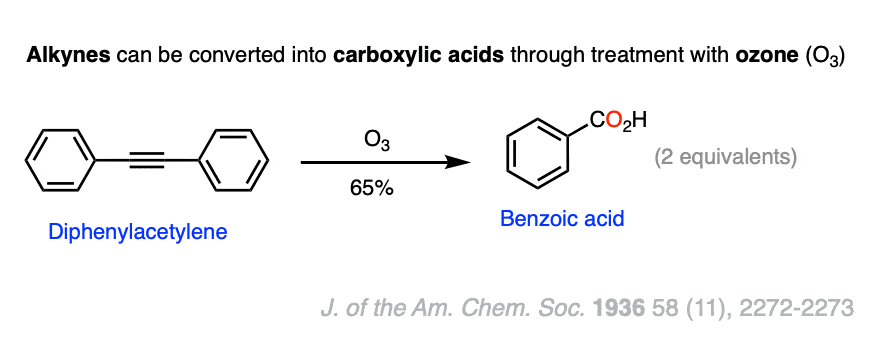
Terminal alkynes, R-C≡C-H, also undergo oxidative cleavage. In this case, the terminal carbon bubbles out of the reaction mixture as carbon dioxide (CO2) and we are left with a chain-shortened carboxylic acid.
For example, 1-hexyne becomes pentanoic acid plus carbon dioxide:
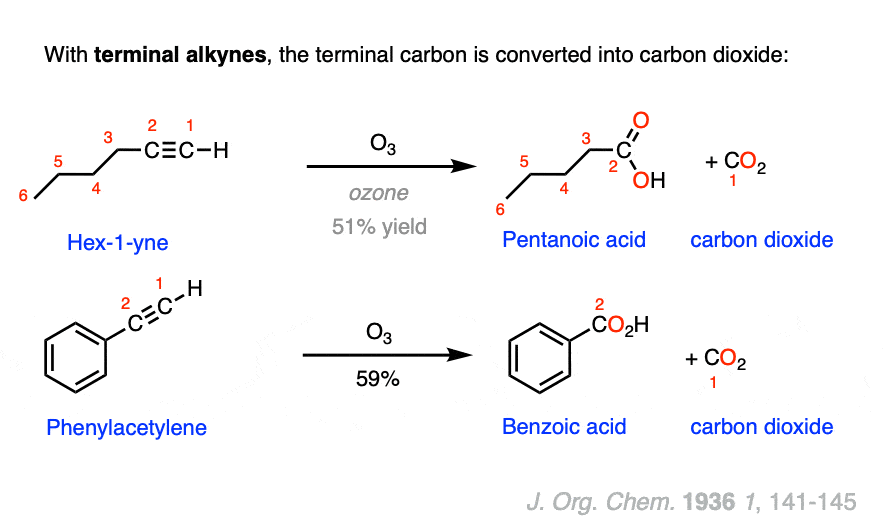
The original product of ozonolysis would be formic acid, HCO2H, but in the presence of ozone the C-H bond is oxidized further to give carbonic acid, CO(OH)2 . Whether during ozonolysis or in a open can of Diet Coke, carbonic acid is in equilibrium with CO2 and H2O, and gradually CO2 is lost to the atmosphere.
2. Cleavage of Alkynes With Permanganate (KMnO4)
Under certain conditions potassium permanganate can also cleave carbon-carbon triple bonds.
For example, it is reported that KMnO4 under either strongly basic or strongly acidic conditions will break apart internal alkynes to give carboxylic acids.
As with ozonolysis, terminal alkynes are converted to the chain-shortened carboxylic acid and one equivalent of CO2.
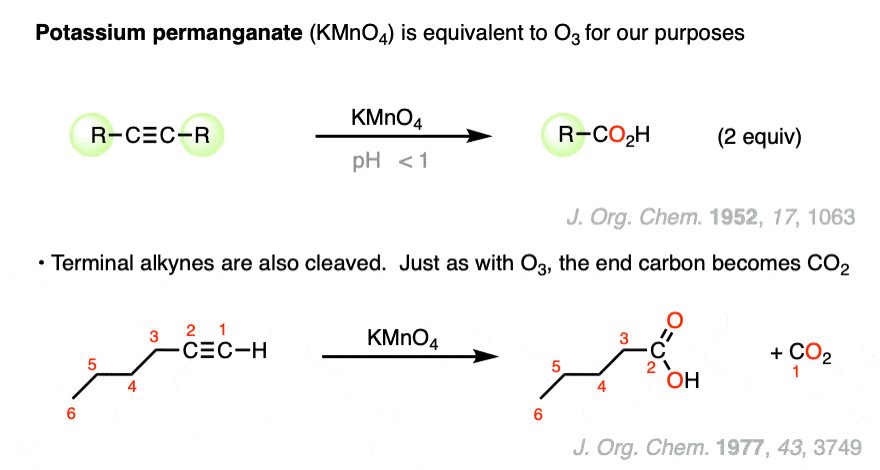
3. Formation of 1,2-Diketones From Alkynes
As noted previously, forming carboxylic acids from alkynes, while occasionally useful, seems like a waste of two good C-C pi bonds that could otherwise be converted into something more interesting.
Thus, I am happy to report to you that under certain condtions, C-C triple bonds can be directly converted into 1,2-diketones.
Here, for example, is the reaction of phenylacetylene with KMnO4 to give benzil.
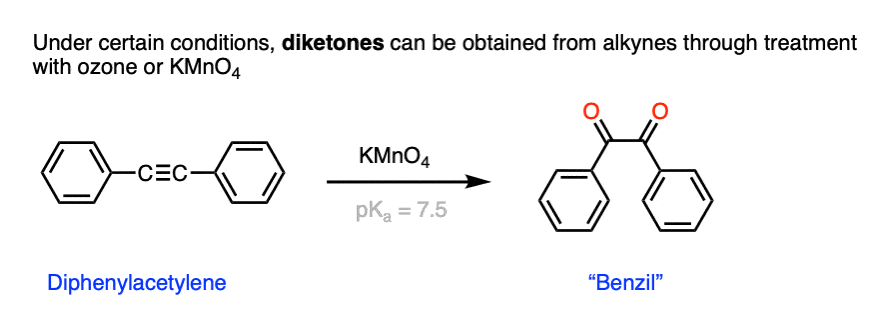
A number of other oxidants (e.g. RuO4) can also carry out this conversion, as does OsO4. [Note 1]
Notes
Related Articles
- Alkynes Are A Blank Canvas
- Synthesis (5) – Reactions of Alkynes
- Hydroboration and Oxymercuration of Alkynes
- Acetylides from Alkynes, And Substitution Reactions of Acetylides
- Partial Reduction of Alkynes With Lindlar’s Catalyst or Na/NH3 To Obtain Cis or Trans Alkenes
- Alkyne Halogenation: Bromination, Chlorination, and Iodination of Alkynes
Some highlights from chapter 13 of Patai’s “Chemistry of Triple Bonded Functional Groups” Part 1, supplement C.
Note 1. On OsO4. Here’s what can happen if alkynes are treated with OsO4. They perform double addition (note that this is a proposed structure, not a conclusive proof) which can then be hydrolyzed to give a diketone.
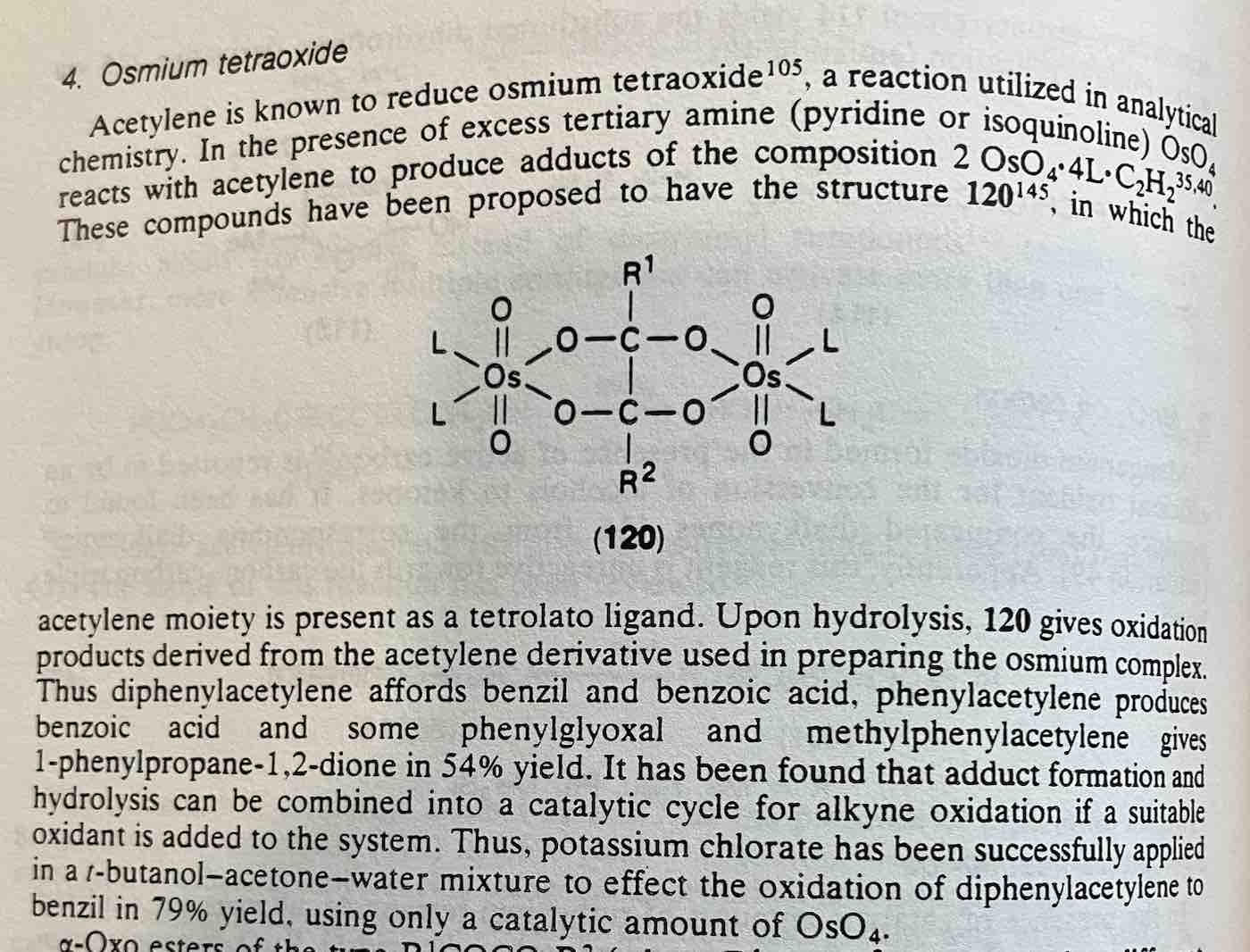
Note 2. The reaction with m-CPBA is even more interesting. Epoxidation of an alkyne gives rise to a transient, very unstable (due to antiaromaticity – see Antiaromatic Compounds And Antiaromaticity) oxirene, which quickly rearranges to an alpha-keto carbene. The carbene can then perform C-H insertion reactions on adjacent alkyl groups, such as t-butyl.
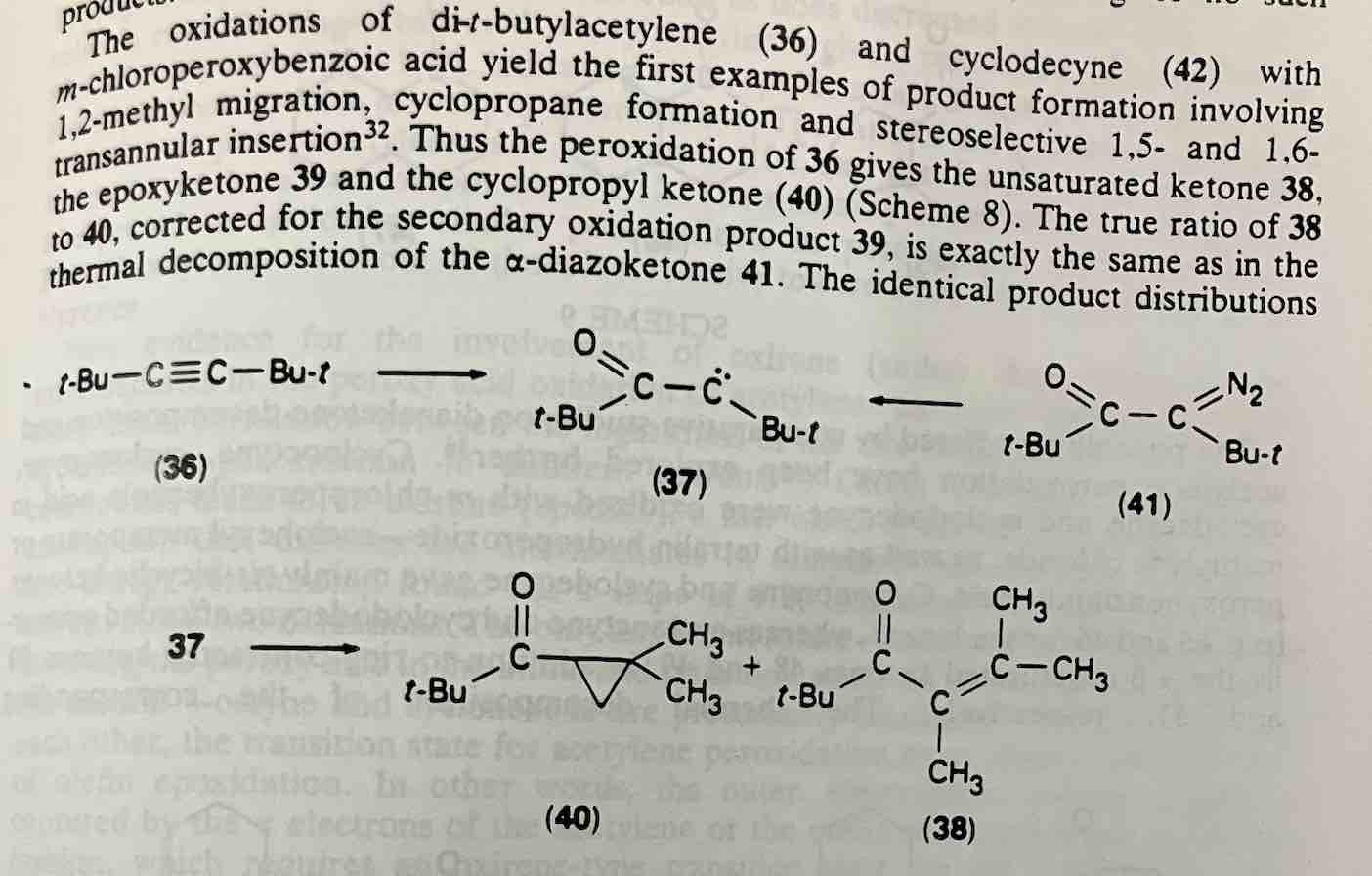
Reactions with cyclic alkynes are even more wild, with transannular C-H insertions to form various bicycles. See JACS 1973, 95, 3284.
Quiz Yourself!
[quizzes]
(Advanced) References and Further Reading
Ozonolysis of alkynes is not commonly performed and tracking down good examples required more than the usual amount of detective work.
Good leading reference is in Patai’s Chemistry of Triple Bonded Functional Groups” Supplement C Part 1 chapt 13, p. 523-524. (Laszlo I. Simandi).
- THE OZONIZATION OF TRIPLE BONDS
CHARLES D. HURD and ROBERT E. CHRIST
The Journal of Organic Chemistry 1936 01 (2), 141-145
DOI: 10.1021/jo01231a002
One of the first published studies of the ozonolysis of triple bonds, with yields in the 45-60% range. - Transformations of alkynes to carboxylic acids and their derivatives via CC bond cleavage
Shivalinga Kollea and Sanjay Batra
Org. Biomol. Chem., 2016,14, 11048-11060
DOI: 10.1039/C6OB01912A
A historical review on carbon-carbon triple bond cleavage and reactions, including ozonolysis, KMnO4, and many other reagents. - The Isolation of 1,2-Diketones from the Ozonization of Disubstituted Acetylenes
Thomas L. Jacobs
Journal of the American Chemical Society 1936 58 (11), 2272-2273
DOI: 10.1021/ja01302a053 - Ozonolysis of Unsymmetrical Acetylenes
PHILIP S. BAILEY, YUN-GER CHANG, and W. W. L. KWIE
The Journal of Organic Chemistry 1962 27 (4), 1198-1201
DOI: 10.1021/jo01051a017 - Ozonolysis of Alkynes—A Flexible Route to Alpha-Diketones: Synthesis of AI-2
Joshua L. Alterman, Dua X. Vang, Marissa Roghair Stroud, Larry J. Halverson, and George A. Kraus
Organic Letters 2020 22 (19), 7424-7426
DOI: 10.1021/acs.orglett.0c02182
A relatively recent application of alkyne ozonolysis, to obtain 1,2-diketones. - Reductive trapping in the ozonolysis of diphenylacetylene
S. Jackson and L. A. Hull
The Journal of Organic Chemistry 1976 41 (20), 3340-3342
DOI: 10.1021/jo00882a037
The authors study the ozonolysis of diphenylacetylene and propose a mechanism for the formation of carboxylic acids similar to that for the ozonolysis of alkenes. - Ozonization and Oxidation of Stearolic Acid to 9, 10-Diketostearic Acid
N. A. Khan and Melvin S. Newman
The Journal of Organic Chemistry 1952 17 (7), 1063-1065
DOI: 10.1021/jo50007a024
This study by Melvin “Newman Projection” Newman shows that actylenes can be oxidized to diketones at mildly basic pH (7.5) but will be cleaved to diacids at either strongly acidic or strongly basic pH. - Potassium permanganate oxidations of terminal olefins and acetylenes to carboxylic acids of one less carbon
A. Paul Krapcho, James R. Larson, and Joyce M. Eldridge
The Journal of Organic Chemistry 1977 42 (23), 3749-3753
DOI: 10.1021/jo00443a026
00 General Chemistry Review
01 Bonding, Structure, and Resonance
- How Do We Know Methane (CH4) Is Tetrahedral?
- Hybrid Orbitals and Hybridization
- How To Determine Hybridization: A Shortcut
- Orbital Hybridization And Bond Strengths
- Sigma bonds come in six varieties: Pi bonds come in one
- Dipole Moments and Dipoles
- A Key Skill: How to Calculate Formal Charge
- The Four Intermolecular Forces and How They Affect Boiling Points
- 3 Trends That Affect Boiling Points
- How To Use Electronegativity To Determine Electron Density (and why NOT to trust formal charge)
- Introduction to Resonance
- How To Use Curved Arrows To Interchange Resonance Forms
- Evaluating Resonance Forms (1) - The Rule of Least Charges
- How To Find The Best Resonance Structure By Applying Electronegativity
- Evaluating Resonance Structures With Negative Charges
- Evaluating Resonance Structures With Positive Charge
- Exploring Resonance: Pi-Donation
- Exploring Resonance: Pi-acceptors
- In Summary: Evaluating Resonance Structures
- Drawing Resonance Structures: 3 Common Mistakes To Avoid
- How to apply electronegativity and resonance to understand reactivity
- Bond Hybridization Practice
- Structure and Bonding Practice Quizzes
- Resonance Structures Practice
02 Acid Base Reactions
- Introduction to Acid-Base Reactions
- Acid Base Reactions In Organic Chemistry
- The Stronger The Acid, The Weaker The Conjugate Base
- Walkthrough of Acid-Base Reactions (3) - Acidity Trends
- Five Key Factors That Influence Acidity
- Acid-Base Reactions: Introducing Ka and pKa
- How to Use a pKa Table
- The pKa Table Is Your Friend
- A Handy Rule of Thumb for Acid-Base Reactions
- Acid Base Reactions Are Fast
- pKa Values Span 60 Orders Of Magnitude
- How Protonation and Deprotonation Affect Reactivity
- Acid Base Practice Problems
03 Alkanes and Nomenclature
- Meet the (Most Important) Functional Groups
- Condensed Formulas: Deciphering What the Brackets Mean
- Hidden Hydrogens, Hidden Lone Pairs, Hidden Counterions
- Don't Be Futyl, Learn The Butyls
- Primary, Secondary, Tertiary, Quaternary In Organic Chemistry
- Branching, and Its Affect On Melting and Boiling Points
- The Many, Many Ways of Drawing Butane
- Wedge And Dash Convention For Tetrahedral Carbon
- Common Mistakes in Organic Chemistry: Pentavalent Carbon
- Table of Functional Group Priorities for Nomenclature
- Summary Sheet - Alkane Nomenclature
- Organic Chemistry IUPAC Nomenclature Demystified With A Simple Puzzle Piece Approach
- Boiling Point Quizzes
- Organic Chemistry Nomenclature Quizzes
04 Conformations and Cycloalkanes
- Staggered vs Eclipsed Conformations of Ethane
- Conformational Isomers of Propane
- Newman Projection of Butane (and Gauche Conformation)
- Introduction to Cycloalkanes
- Geometric Isomers In Small Rings: Cis And Trans Cycloalkanes
- Calculation of Ring Strain In Cycloalkanes
- Cycloalkanes - Ring Strain In Cyclopropane And Cyclobutane
- Cyclohexane Conformations
- Cyclohexane Chair Conformation: An Aerial Tour
- How To Draw The Cyclohexane Chair Conformation
- The Cyclohexane Chair Flip
- The Cyclohexane Chair Flip - Energy Diagram
- Substituted Cyclohexanes - Axial vs Equatorial
- Ranking The Bulkiness Of Substituents On Cyclohexanes: "A-Values"
- Cyclohexane Chair Conformation Stability: Which One Is Lower Energy?
- Fused Rings - Cis-Decalin and Trans-Decalin
- Naming Bicyclic Compounds - Fused, Bridged, and Spiro
- Bredt's Rule (And Summary of Cycloalkanes)
- Newman Projection Practice
- Cycloalkanes Practice Problems
05 A Primer On Organic Reactions
- The Most Important Question To Ask When Learning a New Reaction
- Curved Arrows (for reactions)
- Nucleophiles and Electrophiles
- The Three Classes of Nucleophiles
- Nucleophilicity vs. Basicity
- What Makes A Good Nucleophile?
- What Makes A Good Leaving Group?
- 3 Factors That Stabilize Carbocations
- Equilibrium and Energy Relationships
- 7 Factors that stabilize negative charge in organic chemistry
- 7 Factors That Stabilize Positive Charge in Organic Chemistry
- What's a Transition State?
- Hammond's Postulate
- Learning Organic Chemistry Reactions: A Checklist (PDF)
06 Free Radical Reactions
- Free Radical Reactions
- 3 Factors That Stabilize Free Radicals
- Bond Strengths And Radical Stability
- Free Radical Initiation: Why Is "Light" Or "Heat" Required?
- Initiation, Propagation, Termination
- Monochlorination Products Of Propane, Pentane, And Other Alkanes
- Selectivity In Free Radical Reactions
- Selectivity in Free Radical Reactions: Bromination vs. Chlorination
- Halogenation At Tiffany's
- Allylic Bromination
- Bonus Topic: Allylic Rearrangements
- In Summary: Free Radicals
- Synthesis (2) - Reactions of Alkanes
- Free Radicals Practice Quizzes
07 Stereochemistry and Chirality
- Types of Isomers: Constitutional Isomers, Stereoisomers, Enantiomers, and Diastereomers
- How To Draw The Enantiomer Of A Chiral Molecule
- How To Draw A Bond Rotation
- Introduction to Assigning (R) and (S): The Cahn-Ingold-Prelog Rules
- Assigning Cahn-Ingold-Prelog (CIP) Priorities (2) - The Method of Dots
- Enantiomers vs Diastereomers vs The Same? Two Methods For Solving Problems
- Assigning R/S To Newman Projections (And Converting Newman To Line Diagrams)
- How To Determine R and S Configurations On A Fischer Projection
- The Meso Trap
- Optical Rotation, Optical Activity, and Specific Rotation
- Optical Purity and Enantiomeric Excess
- What's a Racemic Mixture?
- Chiral Allenes And Chiral Axes
- Stereochemistry Practice Problems and Quizzes
08 Substitution Reactions
- Nucleophilic Substitution Reactions - Introduction
- Two Types of Nucleophilic Substitution Reactions
- The SN2 Mechanism
- Why the SN2 Reaction Is Powerful
- The SN1 Mechanism
- The Conjugate Acid Is A Better Leaving Group
- Comparing the SN1 and SN2 Reactions
- Polar Protic? Polar Aprotic? Nonpolar? All About Solvents
- Steric Hindrance is Like a Fat Goalie
- Common Blind Spot: Intramolecular Reactions
- Substitution Practice - SN1
- Substitution Practice - SN2
09 Elimination Reactions
- Elimination Reactions (1): Introduction And The Key Pattern
- Elimination Reactions (2): The Zaitsev Rule
- Elimination Reactions Are Favored By Heat
- Two Elimination Reaction Patterns
- The E1 Reaction
- The E2 Mechanism
- E1 vs E2: Comparing the E1 and E2 Reactions
- Antiperiplanar Relationships: The E2 Reaction and Cyclohexane Rings
- Bulky Bases in Elimination Reactions
- Comparing the E1 vs SN1 Reactions
- Elimination (E1) Reactions With Rearrangements
- E1cB - Elimination (Unimolecular) Conjugate Base
- Elimination (E1) Practice Problems And Solutions
- Elimination (E2) Practice Problems and Solutions
10 Rearrangements
11 SN1/SN2/E1/E2 Decision
- Identifying Where Substitution and Elimination Reactions Happen
- Deciding SN1/SN2/E1/E2 (1) - The Substrate
- Deciding SN1/SN2/E1/E2 (2) - The Nucleophile/Base
- SN1 vs E1 and SN2 vs E2 : The Temperature
- Deciding SN1/SN2/E1/E2 - The Solvent
- Wrapup: The Key Factors For Determining SN1/SN2/E1/E2
- Alkyl Halide Reaction Map And Summary
- SN1 SN2 E1 E2 Practice Problems
12 Alkene Reactions
- E and Z Notation For Alkenes (+ Cis/Trans)
- Alkene Stability
- Alkene Addition Reactions: "Regioselectivity" and "Stereoselectivity" (Syn/Anti)
- Stereoselective and Stereospecific Reactions
- Hydrohalogenation of Alkenes and Markovnikov's Rule
- Hydration of Alkenes With Aqueous Acid
- Rearrangements in Alkene Addition Reactions
- Halogenation of Alkenes and Halohydrin Formation
- Oxymercuration Demercuration of Alkenes
- Hydroboration Oxidation of Alkenes
- m-CPBA (meta-chloroperoxybenzoic acid)
- OsO4 (Osmium Tetroxide) for Dihydroxylation of Alkenes
- Palladium on Carbon (Pd/C) for Catalytic Hydrogenation of Alkenes
- Cyclopropanation of Alkenes
- A Fourth Alkene Addition Pattern - Free Radical Addition
- Alkene Reactions: Ozonolysis
- Oxidative Cleavage of Vicinal Diols With NaIO4 and Pb(OAc)4
- Summary: Three Key Families Of Alkene Reaction Mechanisms
- Synthesis (4) - Alkene Reaction Map, Including Alkyl Halide Reactions
- Alkene Reactions Practice Problems
13 Alkyne Reactions
- Acetylides from Alkynes, And Substitution Reactions of Acetylides
- Partial Reduction of Alkynes With Lindlar's Catalyst
- Partial Reduction of Alkynes With Na/NH3 To Obtain Trans Alkenes
- Alkyne Hydroboration With "R2BH"
- Hydration and Oxymercuration of Alkynes
- Hydrohalogenation of Alkynes
- Alkyne Halogenation: Bromination and Chlorination of Alkynes
- Oxidation of Alkynes With O3 and KMnO4
- Alkenes To Alkynes Via Halogenation And Elimination Reactions
- Alkynes Are A Blank Canvas
- Synthesis (5) - Reactions of Alkynes
- Alkyne Reactions Practice Problems With Answers
14 Alcohols, Epoxides and Ethers
- Alcohols - Nomenclature and Properties
- Alcohols Can Act As Acids Or Bases (And Why It Matters)
- Alcohols - Acidity and Basicity
- The Williamson Ether Synthesis
- Ethers From Alkenes, Tertiary Alkyl Halides and Alkoxymercuration
- Alcohols To Ethers via Acid Catalysis
- Cleavage Of Ethers With Acid
- Epoxides - The Outlier Of The Ether Family
- Opening of Epoxides With Acid
- Epoxide Ring Opening With Base
- Making Alkyl Halides From Alcohols
- Tosylates And Mesylates
- PBr3 and SOCl2
- Elimination Reactions of Alcohols
- Elimination of Alcohols To Alkenes With POCl3
- Alcohol Oxidation: "Strong" and "Weak" Oxidants
- Demystifying The Mechanisms of Alcohol Oxidations
- Protecting Groups For Alcohols
- Thiols And Thioethers
- Calculating the oxidation state of a carbon
- Oxidation and Reduction in Organic Chemistry
- Oxidation Ladders
- SOCl2 Mechanism For Alcohols To Alkyl Halides: SN2 versus SNi
- Alcohol Reactions Roadmap (PDF)
- Alcohol Reaction Practice Problems
- Epoxide Reaction Quizzes
- Oxidation and Reduction Practice Quizzes
15 Organometallics
- What's An Organometallic?
- Formation of Grignard and Organolithium Reagents
- Organometallics Are Strong Bases
- Reactions of Grignard Reagents
- Protecting Groups In Grignard Reactions
- Synthesis Problems Involving Grignard Reagents
- Grignard Reactions And Synthesis (2)
- Organocuprates (Gilman Reagents): How They're Made
- Gilman Reagents (Organocuprates): What They're Used For
- The Heck, Suzuki, and Olefin Metathesis Reactions (And Why They Don't Belong In Most Introductory Organic Chemistry Courses)
- Reaction Map: Reactions of Organometallics
- Grignard Practice Problems
16 Spectroscopy
- Degrees of Unsaturation (or IHD, Index of Hydrogen Deficiency)
- Conjugation And Color (+ How Bleach Works)
- Introduction To UV-Vis Spectroscopy
- UV-Vis Spectroscopy: Absorbance of Carbonyls
- UV-Vis Spectroscopy: Practice Questions
- Bond Vibrations, Infrared Spectroscopy, and the "Ball and Spring" Model
- Infrared (IR) Spectroscopy: A Quick Primer On Interpreting Spectra
- IR Spectroscopy: 4 Practice Problems
- 1H NMR: How Many Signals?
- Homotopic, Enantiotopic, Diastereotopic
- Diastereotopic Protons in 1H NMR Spectroscopy: Examples
- 13-C NMR - How Many Signals
- Liquid Gold: Pheromones In Doe Urine
- Natural Product Isolation (1) - Extraction
- Natural Product Isolation (2) - Purification Techniques, An Overview
- Structure Determination Case Study: Deer Tarsal Gland Pheromone
17 Dienes and MO Theory
- What To Expect In Organic Chemistry 2
- Are these molecules conjugated?
- Conjugation And Resonance In Organic Chemistry
- Bonding And Antibonding Pi Orbitals
- Molecular Orbitals of The Allyl Cation, Allyl Radical, and Allyl Anion
- Pi Molecular Orbitals of Butadiene
- Reactions of Dienes: 1,2 and 1,4 Addition
- Thermodynamic and Kinetic Products
- More On 1,2 and 1,4 Additions To Dienes
- s-cis and s-trans
- The Diels-Alder Reaction
- Cyclic Dienes and Dienophiles in the Diels-Alder Reaction
- Stereochemistry of the Diels-Alder Reaction
- Exo vs Endo Products In The Diels Alder: How To Tell Them Apart
- HOMO and LUMO In the Diels Alder Reaction
- Why Are Endo vs Exo Products Favored in the Diels-Alder Reaction?
- Diels-Alder Reaction: Kinetic and Thermodynamic Control
- The Retro Diels-Alder Reaction
- The Intramolecular Diels Alder Reaction
- Regiochemistry In The Diels-Alder Reaction
- The Cope and Claisen Rearrangements
- Electrocyclic Reactions
- Electrocyclic Ring Opening And Closure (2) - Six (or Eight) Pi Electrons
- Diels Alder Practice Problems
- Molecular Orbital Theory Practice
18 Aromaticity
- Introduction To Aromaticity
- Rules For Aromaticity
- Huckel's Rule: What Does 4n+2 Mean?
- Aromatic, Non-Aromatic, or Antiaromatic? Some Practice Problems
- Antiaromatic Compounds and Antiaromaticity
- The Pi Molecular Orbitals of Benzene
- The Pi Molecular Orbitals of Cyclobutadiene
- Frost Circles
- Aromaticity Practice Quizzes
19 Reactions of Aromatic Molecules
- Electrophilic Aromatic Substitution: Introduction
- Activating and Deactivating Groups In Electrophilic Aromatic Substitution
- Electrophilic Aromatic Substitution - The Mechanism
- Ortho-, Para- and Meta- Directors in Electrophilic Aromatic Substitution
- Understanding Ortho, Para, and Meta Directors
- Why are halogens ortho- para- directors?
- Disubstituted Benzenes: The Strongest Electron-Donor "Wins"
- Electrophilic Aromatic Substitutions (1) - Halogenation of Benzene
- Electrophilic Aromatic Substitutions (2) - Nitration and Sulfonation
- EAS Reactions (3) - Friedel-Crafts Acylation and Friedel-Crafts Alkylation
- Intramolecular Friedel-Crafts Reactions
- Nucleophilic Aromatic Substitution (NAS)
- Nucleophilic Aromatic Substitution (2) - The Benzyne Mechanism
- Reactions on the "Benzylic" Carbon: Bromination And Oxidation
- The Wolff-Kishner, Clemmensen, And Other Carbonyl Reductions
- More Reactions on the Aromatic Sidechain: Reduction of Nitro Groups and the Baeyer Villiger
- Aromatic Synthesis (1) - "Order Of Operations"
- Synthesis of Benzene Derivatives (2) - Polarity Reversal
- Aromatic Synthesis (3) - Sulfonyl Blocking Groups
- Birch Reduction
- Synthesis (7): Reaction Map of Benzene and Related Aromatic Compounds
- Aromatic Reactions and Synthesis Practice
- Electrophilic Aromatic Substitution Practice Problems
20 Aldehydes and Ketones
- What's The Alpha Carbon In Carbonyl Compounds?
- Nucleophilic Addition To Carbonyls
- Aldehydes and Ketones: 14 Reactions With The Same Mechanism
- Sodium Borohydride (NaBH4) Reduction of Aldehydes and Ketones
- Grignard Reagents For Addition To Aldehydes and Ketones
- Wittig Reaction
- Hydrates, Hemiacetals, and Acetals
- Imines - Properties, Formation, Reactions, and Mechanisms
- All About Enamines
- Breaking Down Carbonyl Reaction Mechanisms: Reactions of Anionic Nucleophiles (Part 2)
- Aldehydes Ketones Reaction Practice
21 Carboxylic Acid Derivatives
- Nucleophilic Acyl Substitution (With Negatively Charged Nucleophiles)
- Addition-Elimination Mechanisms With Neutral Nucleophiles (Including Acid Catalysis)
- Basic Hydrolysis of Esters - Saponification
- Transesterification
- Proton Transfer
- Fischer Esterification - Carboxylic Acid to Ester Under Acidic Conditions
- Lithium Aluminum Hydride (LiAlH4) For Reduction of Carboxylic Acid Derivatives
- LiAlH[Ot-Bu]3 For The Reduction of Acid Halides To Aldehydes
- Di-isobutyl Aluminum Hydride (DIBAL) For The Partial Reduction of Esters and Nitriles
- Amide Hydrolysis
- Thionyl Chloride (SOCl2) And Conversion of Carboxylic Acids to Acid Halides
- Diazomethane (CH2N2)
- Carbonyl Chemistry: Learn Six Mechanisms For the Price Of One
- Making Music With Mechanisms (PADPED)
- Carboxylic Acid Derivatives Practice Questions
22 Enols and Enolates
- Keto-Enol Tautomerism
- Enolates - Formation, Stability, and Simple Reactions
- Kinetic Versus Thermodynamic Enolates
- Aldol Addition and Condensation Reactions
- Reactions of Enols - Acid-Catalyzed Aldol, Halogenation, and Mannich Reactions
- Claisen Condensation and Dieckmann Condensation
- Decarboxylation
- The Malonic Ester and Acetoacetic Ester Synthesis
- The Michael Addition Reaction and Conjugate Addition
- The Robinson Annulation
- Haloform Reaction
- The Hell–Volhard–Zelinsky Reaction
- Enols and Enolates Practice Quizzes
23 Amines
- The Amide Functional Group: Properties, Synthesis, and Nomenclature
- Basicity of Amines And pKaH
- 5 Key Basicity Trends of Amines
- The Mesomeric Effect And Aromatic Amines
- Nucleophilicity of Amines
- Alkylation of Amines (Sucks!)
- Reductive Amination
- The Gabriel Synthesis
- Some Reactions of Azides
- The Hofmann Elimination
- The Hofmann and Curtius Rearrangements
- The Cope Elimination
- Protecting Groups for Amines - Carbamates
- The Strecker Synthesis of Amino Acids
- Introduction to Peptide Synthesis
- Reactions of Diazonium Salts: Sandmeyer and Related Reactions
- Amine Practice Questions
24 Carbohydrates
- D and L Notation For Sugars
- Pyranoses and Furanoses: Ring-Chain Tautomerism In Sugars
- What is Mutarotation?
- Reducing Sugars
- The Big Damn Post Of Carbohydrate-Related Chemistry Definitions
- The Haworth Projection
- Converting a Fischer Projection To A Haworth (And Vice Versa)
- Reactions of Sugars: Glycosylation and Protection
- The Ruff Degradation and Kiliani-Fischer Synthesis
- Isoelectric Points of Amino Acids (and How To Calculate Them)
- Carbohydrates Practice
- Amino Acid Quizzes
25 Fun and Miscellaneous
- A Gallery of Some Interesting Molecules From Nature
- Screw Organic Chemistry, I'm Just Going To Write About Cats
- On Cats, Part 1: Conformations and Configurations
- On Cats, Part 2: Cat Line Diagrams
- On Cats, Part 4: Enantiocats
- On Cats, Part 6: Stereocenters
- Organic Chemistry Is Shit
- The Organic Chemistry Behind "The Pill"
- Maybe they should call them, "Formal Wins" ?
- Why Do Organic Chemists Use Kilocalories?
- The Principle of Least Effort
- Organic Chemistry GIFS - Resonance Forms
- Reproducibility In Organic Chemistry
- What Holds The Nucleus Together?
- How Reactions Are Like Music
- Organic Chemistry and the New MCAT
26 Organic Chemistry Tips and Tricks
- Common Mistakes: Formal Charges Can Mislead
- Partial Charges Give Clues About Electron Flow
- Draw The Ugly Version First
- Organic Chemistry Study Tips: Learn the Trends
- The 8 Types of Arrows In Organic Chemistry, Explained
- Top 10 Skills To Master Before An Organic Chemistry 2 Final
- Common Mistakes with Carbonyls: Carboxylic Acids... Are Acids!
- Planning Organic Synthesis With "Reaction Maps"
- Alkene Addition Pattern #1: The "Carbocation Pathway"
- Alkene Addition Pattern #2: The "Three-Membered Ring" Pathway
- Alkene Addition Pattern #3: The "Concerted" Pathway
- Number Your Carbons!
- The 4 Major Classes of Reactions in Org 1
- How (and why) electrons flow
- Grossman's Rule
- Three Exam Tips
- A 3-Step Method For Thinking Through Synthesis Problems
- Putting It Together
- Putting Diels-Alder Products in Perspective
- The Ups and Downs of Cyclohexanes
- The Most Annoying Exceptions in Org 1 (Part 1)
- The Most Annoying Exceptions in Org 1 (Part 2)
- The Marriage May Be Bad, But the Divorce Still Costs Money
- 9 Nomenclature Conventions To Know
- Nucleophile attacks Electrophile
27 Case Studies of Successful O-Chem Students
- Success Stories: How Corina Got The The "Hard" Professor - And Got An A+ Anyway
- How Helena Aced Organic Chemistry
- From a "Drop" To B+ in Org 2 – How A Hard Working Student Turned It Around
- How Serge Aced Organic Chemistry
- Success Stories: How Zach Aced Organic Chemistry 1
- Success Stories: How Kari Went From C– to B+
- How Esther Bounced Back From a "C" To Get A's In Organic Chemistry 1 And 2
- How Tyrell Got The Highest Grade In Her Organic Chemistry Course
- This Is Why Students Use Flashcards
- Success Stories: How Stu Aced Organic Chemistry
- How John Pulled Up His Organic Chemistry Exam Grades
- Success Stories: How Nathan Aced Organic Chemistry (Without It Taking Over His Life)
- How Chris Aced Org 1 and Org 2
- Interview: How Jay Got an A+ In Organic Chemistry
- How to Do Well in Organic Chemistry: One Student's Advice
- "America's Top TA" Shares His Secrets For Teaching O-Chem
- "Organic Chemistry Is Like..." - A Few Metaphors
- How To Do Well In Organic Chemistry: Advice From A Tutor
- Guest post: "I went from being afraid of tests to actually looking forward to them".
why doesn’t Dihydroxylation With OsO4 work on alkynes ecen though Dihydroxylation With KMnO4 dose work on alkynes
That is a great question. Very simple question, but difficult to answer. Related question: ruthenium is just above Os in the periodic table, but RuO4 will oxidize alkynes to diketones whereas OsO4 does not. Why?
The best I can find is this paper, which covers alkenes (not alkynes). The gist of it is that Os is more stable at higher oxidation states (e.g. Os(VIII), Os(VI) ) relative to smaller elements such as Ru and presumably Mn.
RuO4 is more similar in many respects to KMnO4 than it is to OsO4 – will do many of the same reactions, even though they are not even in the same column of the periodic table.
I suppose the best answer I can give you is that chemistry is as yet an incomplete science, and there are some questions we are still trying to figure out the answers to.
can you a give an intutituve explanation regarding the failiure of dihydroxylation of alkynes via OsO4 sir?
Alkynes are generally less electron-rich than alkenes, owing to the larger electronegativity of sp hybridized carbon atoms. Electrophilic reagents like ozone, HX and OsO4 tend to react more slowly with alkynes.
Regarding why OsO4 doesn’t work, I’m not entirely sure.
http://link.springer.com/article/10.1023%2FA%3A1012733023065#page-1
this paper also show cyclopropanation of an alkyne.
Alkynes CAN be cyclopropanated, it’s just that this topic almost never comes up in introductory organic chemistry.
The comment on OsO4 not working with alkynes prompted me to look it up. It is discussed here on page 10.
http://nptel.ac.in/courses/104103023/download/module1.pdf
When does it work, and when doesn’t it?
That is new to me.
This didn’t appear in my copy of March, nor any other book in my collection, and I don’t have Scifinder at my fingertips anymore to really dig into the literature.
I’d need to see the primary literature to know the exact conditions for the reaction. It’s very possible to selectively dihydroxylate an alkene in the presence of an alkyne; reactions with alkynes are much slower.
Thanks for adding this.
For what it’s worth, I cannot find the first reaction (oxidation of diphenylacetylene to benzil with osmium tetroxide) on Reaxys. Quite a variety of oxidants have been used for this particular substrate, including KMnO4 which is perhaps more familiar to undergrads (JOC 1989 5182), but not OsO4.
The second substrate is even more dubious. There is only one report of this transformation (TL 2004 8575) using trifluoro DMDO, not OsO4, and the authors report that the 1,2-diketone was only a side product, obtained in 18% yield (the main product being that with the hydroxyls oxidised to carbonyls). I don’t know where the “OsO4/KClO3” comes from, but it’s not in the primary literature.
Thanks for digging through the literature, Jon. Much appreciated.